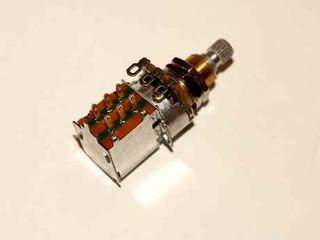In the third instalment of the Guitar Repairs 101 column, Ed talks us through switching options. Read the rest of his instalments on coil-splitting a humbucking pickup.
By now you should have a humbucker that you can coil-split, a wiring diagram and the tools that we featured in part one of this guide. That's all gravy but there's still one component we need to sort out before we can put this coil-splitting thing to bed. It's time to look at switches...
Choosing the right switch for the job
When it comes to switches for coil-splitting you have a couple of options. By the way, we get our switches and other parts from WD Music... they'll hook you up with the right parts. For this job you could use a DPDT (Double Pole, Double Throw) mini switch. The only problem with mini switches is that you'll have to drill a small hole in your guitar's scratchplate or top to install them. Not ideal.
We prefer to use a push pull potentiometer (or 'pot') with a built-in DPDT switch. The coil-split function is activated when you pull the pot's knob up. The great thing with these pots is that you don't have to permanently modify your guitar to fit them. You can install the push pull pot as a replacement for your volume or tone control. Also note that if you're coil-splitting both pickups in a twin-bucker guitar you'll need two push pull pots - one to coil-split each pickup.
When you're cruising webstore pages you'll notice that push pull pots are available in 250K or 500K formats. As we're working with 'buckers we'll need to use the 500K pot. 250K pots are designed for use with single-coil pickups.
Incidentally, if you have a Gibson Les Paul or a similar guitar with a thick top you might need long shaft push pull pots. Before you order your new DPDT pot measure the threaded part on the old unit to make sure you get the right part.
Next time we'll be looking at the noble art of soldering. Brandishing a soldering iron correctly is an essential skill for any guitar tinkerer and you won't be able to finish this job without it. Stick with us and you'll be soldering like a pro... honest!
See you next month! Ed Mitchell - FixYourOwnDamnGuitar.com
Check out Ed's Shed in Total Guitar issue 204 (a classic rock special) for advice on choosing the right guitar polish/cleaner.

